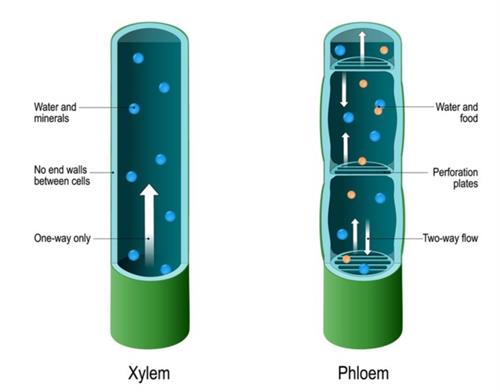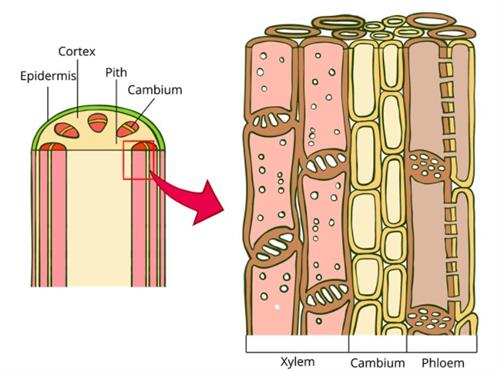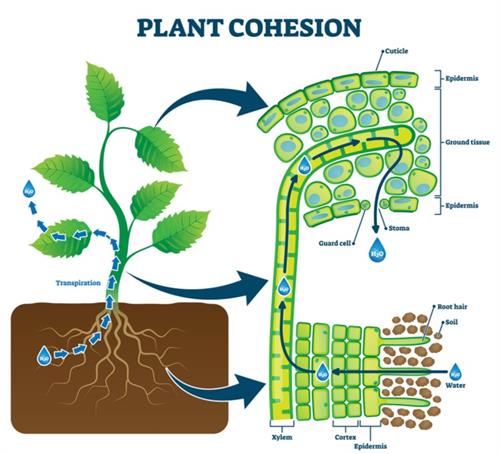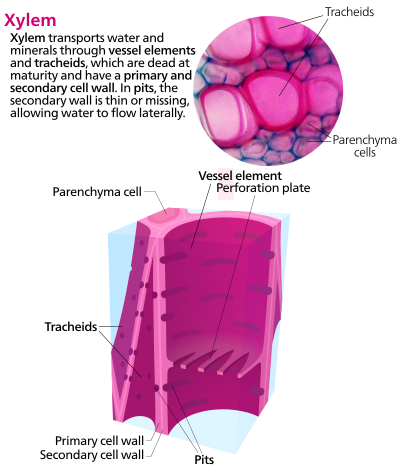PDF chapter test TRY NOW
We see that water from the ground is pumped to the upper storage tank through a pipe in a house. Also, it is distributed to all regions of the house through various pipelines. Plants similarly conduct food and water, using pipe-like structures that extend across the plant like continuous tunnels. These pipe-like structures are complex permanent tissues.

Biological structure scheme of inner vascular in plant
Complex permanent tissues:
Complex permanent tissue is defined as a group of heterogeneous cells performing a common function.
A complex permanent tissue made up of different types of cells having a common origin. Even though the cells' appearance is different, but all working as a unit to perform a particular function.
Complex permanent tissues are of two types.
- Xylem
- Phloem

Complex permanent tissues
They are also called vascular tissues or conducting tissues, mainly made up of parenchyma and sclerenchyma cells, but collenchymatous cells are not present in complex permanent tissues. Xylem and phloem are the most complex tissues in plants. They are part of the vascular bundles. Vascular or conductive tissue is a distinctive feature of thorny plants. It has made possible their survival in a terrestrial environment.

Plant cohesion vector illustration. Labeled water upward motion explanation with educational scheme. Biological structure diagram with xylem, cortex, epidermis and ground tissue cross section view.
The tissues associated with the conduction of water, minerals and food materials in plants are called vascular tissue.
Plants with a well developed conductive system are thus called vascular plants.
1. Xylem:
C. Nageli introduced the term xylem in \(1858\). The word "xylem" is extracted from the Greek word "Xylos", meaning "wood". Xylem is a complex permanent, conducting tissue that conducts water and mineral nutrients in only an upward direction from root to leaves (unidirectional). It is responsible for the transport of water and minerals from roots to other parts of the plant, and it also provides mechanical support to the plant. The cells of the xylem has thick lignified walls, and many of them are dead. It is a heterogeneous tissue consist of various elements. They are further divided into four components.
a) Xylem Tracheids
b) Xylem fibres
c) Xylem parenchyma
d) Xylem vessels or trachea
b) Xylem fibres
c) Xylem parenchyma
d) Xylem vessels or trachea

Xylem cells
Xylem tracheids:
- It is present in vascular plants groups like pteridophytes, Gymnosperms (non-flowering plants) and Angiosperms (flowering plants).
- It is an elongated tubular dead cells with hard, thick and lignified walls. Their ends are tapering (sharp), blunt, or chisel-like. It has imperforated (without pores) ends.
- The chief water-conducting elements of the xylem in gymnosperms are tracheids. They have a large lumen without any content.
- Tracheids are one of the non-living components (without cytoplasm and nucleus) of the xylem.
- Due to lignification, the cells cannot exchange the essential materials with the outside environment. These cells lose their living characters at maturity and become dead.
Functions:
- They transport water, and mineralsalts are conducted upward direction from one tracheid to another.
- It provides mechanical support to the plants.
Xylem fibres:
- These are elongated lignified dead cells with sharp at both the ends and thick cell walls.
- These are fibres associated with the xylem and supportive in the functioning of the xylem.
Function:
- It helps to conductwater and nutrients from the root to the leaf.
- It provides mechanical support to the plant.
Xylem vessels:
- Vessels are predominantly found in Angiosperms (flowering plants).
- Vessels are also called trachea because of their resemblance to the trachea of insects.
- These are long, cylindrical tube-like structures.
- They are arranged in longitudinal series in which the partitioned walls (transverse walls) are perforated, and so the entire structure looks-like a water pipe.
- These are also dead cells with lignified secondary walls, and hence it does not have protoplast.
Function:
- Vessels are efficient in conducting water due to the presence of perforations. They transport water and minerals vertically, i.e. from root to leaf transport.
- It also provides mechanical strength to the plant.
Xylem parenchyma:
- The parenchyma associated with xylem is called xylem parenchyma or wood parenchyma.
- These are the only living cells of xylem with thin cell walls. The cells are with abundance of cytoplasm and a prominent nucleus.
Function:
- It helps store food such as starch and fatty substances like oil.
- It helps in the lateral (sideways) conduction of water.
Important!
Tracheids and vessels together called tracheary elements because they conduct sap.
Reference:
https://commons.wikimedia.org/wiki/File:Xylem_cells.svg
